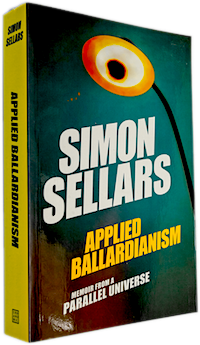It’s been a decade. A decade without J.G. Ballard. It should be more noticeable. Like filling the empty pool with emptiness, to paraphrase China Miéville. Like losing Bowie or Prince. A void of perspective, crumbling and gaping at our heels. Everyone should feel it.
His work has been translated to the screen by directors with styles as varied as Steven Spielberg (Empire of the Sun) and David Cronenberg (Crash). He was interviewed by countless talented writers, including Jon Savage, V. Vale, Will Self, Richard Kadrey, John Gray, Simon Sellars, and Mark Dery. His influence is found in sound from Joy Division, The Jesus and Mary Chain, Sisters of Mercy, K.K. Null, and Gary Numan to Madonna, Radiohead, Trevor Horn, Cadence Weapon, and Danny Brown. His writing and thinking are broad enough to elude categories and focused enough to remain absolutely singular. His work gerrymanders genre distinctions, defining and defying its own boundaries as it goes. I think of him in the same way I think of Thomas Pynchon, Don DeLillo, and Samuel R. Delany: as giants beyond genre.
“I suppose we are moving into a realm where inner space is no longer just inside our skulls but is in the terrain we see around us in everyday life,” Ballard told Carol Orr in 1974:
We are moving into a world where the elements of fiction are that world—and by fiction I mean anything invented to serve imaginative ends, whether it is invented by an advertising agency, a politician, an airline, or what have you. These elements have now crowded out the old-fashioned elements of reality (p. 62; see also Ballard, 1985 p. 4-5).
 Since then a lot of mental offloading and cognitive outsourcing has occurred, our inner thoughts texture-mapped onto every surface. In that meantime some of Ballard’s children have emerged in mongrel forms and curtained corners of mass media. Think Wild Palms or Jackass or the ever-blurring lines between reality and show, news and entertainment. “It’s not news,” he wrote, “it’s entertainment news. A documentary on brain surgery is about entertainment brain surgery.” Inversely, Ballard collaged and kludged together the sets of his own Atrocity Exhibition out of internal organs: “[T]he nervous systems of the characters have been externalized, as part of the reversal of the interior and exterior worlds. Highways, office blocks, faces, and street signs are perceived as if they were elements in a malfunctioning central nervous system” (p. 76). Michel de Certeau once wrote, “Books are only metaphors of the body” (p. 140). Ballard often seemed to be crash-testing that idea.
Since then a lot of mental offloading and cognitive outsourcing has occurred, our inner thoughts texture-mapped onto every surface. In that meantime some of Ballard’s children have emerged in mongrel forms and curtained corners of mass media. Think Wild Palms or Jackass or the ever-blurring lines between reality and show, news and entertainment. “It’s not news,” he wrote, “it’s entertainment news. A documentary on brain surgery is about entertainment brain surgery.” Inversely, Ballard collaged and kludged together the sets of his own Atrocity Exhibition out of internal organs: “[T]he nervous systems of the characters have been externalized, as part of the reversal of the interior and exterior worlds. Highways, office blocks, faces, and street signs are perceived as if they were elements in a malfunctioning central nervous system” (p. 76). Michel de Certeau once wrote, “Books are only metaphors of the body” (p. 140). Ballard often seemed to be crash-testing that idea.
The transmedia spread of everted inner space is nowhere more evident than on this confounded internet. William Gibson said as much in his novel Spook Country (Putnam, 2007, pp. 63-64). As Simon Sellars points out, unlike the cyberpunks who followed him, Ballard’s maps of these near futures weren’t as celebratory as they were cautionary: Dangerous Curves Ahead. Slow Down.
Sellars’ Applied Ballardianism (Urbanomic, 2018), aptly subtitled “Memoir from a Parallel Universe,” is an appropriately Ballardian blend of genres. Memoir, yes, but also biography, travel writing, narrative nonfiction, and, of course, science fiction. I haven’t finished reading it. I’m still finding my way. I’m also trying to take my time. Michel de Certeau wrote elsewhere, “What the map cuts up, the story cuts across” (p. 129). This is a map of a different terrain and a story of a different cut. I aim to enjoy it.
I feel it goes without saying, but I’ll say it anyway: This is the way, step inside.
References:
Ballard, J. G. (1970). The Atrocity Exhibition. London: Jonathan Cape.
Ballard, J. G. (1985). Crash. New York: Vintage.
Ballard, J. G. (2012). Extreme Metaphors: Collected Interviews. Simon Sellars & Dan O’Hara, Eds. London: Fourth Estate.
de Certeau, Michel . (1984). The Practice of Everyday Life. Berkeley, CA: University of California Press.
Gibson, William. (2007). Spook Country. New York: Putnam.
Miéville, China. (2008). Introduction. In J. G. Ballard, Miracles of Life: Shanghai to Shepperton, an Autobiography. New York: Liveright, pp. ix-xiv.
Sellars, Simon. (2018). Applied Ballardianism: Memoir from a Parallel Universe. Falmouth, UK: Urbanomic.
I marshal the middle between Mathers and McLuhan.
Editor of Boogie Down Predictions (Strange Attractor, 2022), author of Dead Precedents (Repeater, 2019) and The Medium Picture (UGA Press, 2025), among others.
